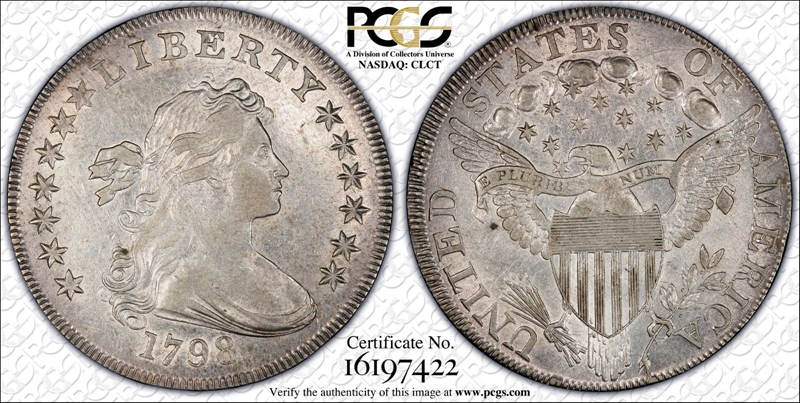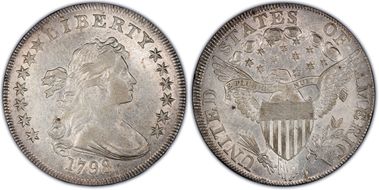1798 $1 BB-124 AU55 认证号16197422, PCGS号40041
拥有者评论
B-24,BB-124. Nice luster. Weak in center and left stars is common. R2. Est.Pop. 600-1200 coins. Probably low in CC.
专家评论
Q. David Bowers
The following narrative, with minor editing, is from my "Silver Dollars & Trade Dollars of the United States: A Complete Encyclopedia" (Wolfeboro, NH: Bowers and Merena Galleries, Inc., 1993). Note: the Notable Specimens list should be used with caution - it has been updated in my 2013 edition of "The Encyclopedia of United States Silver Dollars 1794-1804.""Blundered Stars Reverse."
Line star pattern (placed too high).
(B-24. H-24.)
OBVERSE 18: This die resembles the obverse of BB-122 more than any other and, in fact, in 1881 was confused with it by Capt. J.W. Haseltine in his Type-Table. In BB-122 the 8 in date is about twice as close to bust as in BB-124. In BB-124 the 11th and 12th stars are much farther apart than in BB-122. In BB-124 the first two stars at lower left, point to the center of denticles. In BB-122 the second star points to left edge of a denticle. Also in BB-122 the highest curl on head is solid and under upright of E, while in BB-124 this curl is sketchy and defective and a little more centered under E. The BB-124 obverse has three die file marks to the right of the date. This obverse was first described by M.H. Bolender in 1950.
Obverse die used to strike 1798 BB-124 only.
REVERSE T: See description under 1798 BB-123. Reverse die used to strike 1798 BB-123 (earliest state), BB-124 (intermediate state, now relapped); and 1799 BB-152 (latest state).
DIE STATES:
Die State I: Perfect obverse die, without lapping. May not exist.
Die State II: Dies as described above. Obverse die relapped; highest wave of hair imperfect. No obverse die cracks. Reverse die relapped since use on BB-123; some arrows faint, leaf below C partially missing. Somewhat scarce; perhaps 20% of BB-124 dollars are of this die state. Usually seen with stars on reverse fairly well struck. May also exist with reverse die crack lighter, as in BB-124.
Die State III: As above, but with die crack just beginning at star 12; hairline crack extends to border; crack inward a short distance into the field, On the reverse, the stars above and to the right of the eagle's head are always weakly struck, due to damage and bulging at the corresponding part of the obverse; this weakness continues on all later die states. Only a few BB-124 dollars are of this state.
Die State III: Bolender-24a. Later state with die crack from neck through right field, star 12, to border. Another crack through lower 4 stars on right to bust. Another crack from lowest curl through top of 798 to border under point of bust. Small crack from border down to B. Die state usually seen.
Die State IV: Additional obverse crack develops from star 1 down along border to below numerals 17 in date. Another crack begins at 9, goes through upper part of 8, to border near bust. A skein of minor cracks develops between the rim and star 4. Hairline crack along border from star 1 to star 4. A few BB-124 dollars are of this die state.
Die State V: The lower right obverse eventually shatters; coins from this late state may have been struck in 1799.
COLLECTING NOTES: BB-124 is one of the most common varieties of the year. The population is estimated to be in the range of 600 to 1,100 pieces. Specimens are plentiful from worn grades through AU. Mint State coins are very rare. Probably, some called Uncirculated years ago would merit the AU grade today. The EF coin in the Bolender Collection (sold in 1952), earlier in the Loyd B. Gettys and Col. E.H.R. Green collections, had the reverse off center to the right; apparently, the obverse was centered; this indicates the dies were misaligned axially.
NOTABLE SPECIMENS:
Robertson Specimen. MS-63. J. Douglas Robertson Collection, San Diego Sale, Mid-American Rare Coin Auctions, September 1989, Uncirculated.
Kagin Specimen. MS-63. Kagin's Metropolitan Washington Convention Sale, 1980:710. "Choice BU-63, die cracks, at right leading to die failure at shoulder before hair strands and corresponding portion of reverse, short mark at top right reverse. Sharp stars and hair strands. Lovely lustrous gray bluish golden lustre."
Newport Specimen. MS-60. Bowers and Ruddy Galleries, Newport Collection, 1975:1044. "Beautiful Uncirculated, with dusky mottled brown and gray toning. Pristine, uncleaned. Some very minor adjustment marks are visible with a glass on the reverse."
Hollinbeck-Kagin Specimen. AU-58. Hollinbeck-Kagin, June 1970:615. "Die failure causing some of reverse stars not to be fully struck up, virtually Uncirculated, only barest rubbing on high points. Sometimes called 'AMERICAI' variety due to heavy vertical die break after Iinal A in AMERICA." Hollinbeck-Kagin, August 1970: 1081. "Uncirculated golden, however, the die break (Obverse) ... resulted in three stars of reverse not being fully struck up; a lovely specimen with only the barest trace of rubbing (the old-time 'cabinet friction')." These may or may not be the same specimen.
Pine Tree Specimen. AU-55. Pine Tree, Suburban Washington Convention Sale, 1975:242. "Obverse shattered at lower right, though without the severe bulges [of a later state]; reverse extensively cracked and rusted. Borderline Uncirculated, brilliant and pale gold tone, not well struck up on drapery or corresponding area of stars, and clouds."
Hirt and Bolt Specimen. AU-55. Pine Tree, Hirt and Bolt Collections, 1975:759. "Better than AU, mint brilliance blending willi pale gold tone. Weakly struck on drapery and corresponding area of stars. and clouds, elsewhere bolder, faint signs of rub on breast feathers and hair above temple, tiny reverse rim nicks, small obverse rim planchet defect superficially looking like a nick."
Van Cleave Specimen. AU-55. Kagin's, 1986:3406. "Sharp squared denticles on the obverse and stars which are virtually fully struck. Some lustre remains on periphery and both sides exhibit nice original color. A few very small marks on Miss Liberty's cheek and neck but otherwise essentially as struck."
PCGS #
40041
设计师
Robert Scot
边缘
Lettered: HUNDRED CENTS ONE DOLLAR OR UNIT
直径
40.00 毫米
重量
27.00 克
铸币数量
287536
金属成分
90% Silver, 10% Copper
更高评级数量
0
评级较低的钱币数量
19
地区
The United States of America
价格指南
PCGS 数量报告
拍卖 - PCGS 评级的
拍卖 - NGC 评级的






















